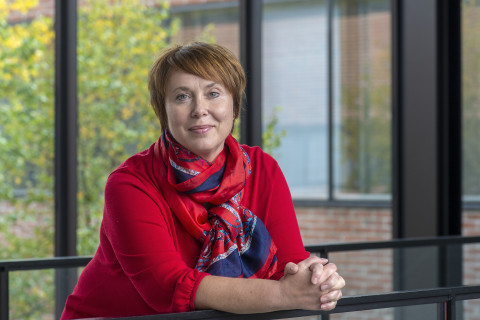Biophotonics: the next step in the study of biological samples
“Physics is the fundamental background of everything around us, from life to the universe,“ Professor Polina Kuzhir says.
Professor Polina Kuzhir got her PhD in theoretical particles and high energy physics in 1996 from the Institute of Physics at the National Academy of Sciences of Belarus.
“Since then, I have passed through all the steps of the academic career, from early stage to senior researcher, and to Head of Laboratory at the Institute for Nuclear Problems at the Belarusian State University, BSU. From very early on, I’ve been deeply involved in collaborative projects led by the European organisation for nuclear research, CERN, and the National Institute for Nuclear Physics of Italy.“
“In 2005, I decided to change my field of research to nanomaterials and nanotechnologies because I realised that my experience in electromagnetics and device modelling can open up new horizons for me in this fascinating and rapidly growing domain,” Kuzhir says.
Being active in international cooperation, Professor Kuzhir has been involved as a BSU team leader in the implementation of nine collaborative research projects funded by the EU. Among them are four Horizon 2020 projects involving UEF. These are ‘Collective Excitations in Advanced Nanostructures’, which was carried out in 2015–2019, Graphene Flagship (2014-2018) Future and Emagine Technologies programme of FP7 and Horizon 2020, ATTRACT phase 1 (2018-2020) large infrastructural project coordinated by CERN and Dirac Semimetals based Terahertz Components, which is running from 2019 to 2024.
”I am happy to announce that yesterday we had been informed that our ATTRACT phase 2 Horizon 2020 project has recommended for funding. This project is devoted to development of the nanocarbon based THz detectors and addresses high Technology readiness level.”
“I visited UEF in 2008 for the first time, when I attended the 1st Nanocarbon Photonics and Optoelectronics conference organised by Professor Yuri Svirko. From there, we started to collaborate in the field of microwave and THz photonics of low-dimensional materials, and we have co-authored more than 20 research papers.”
“In 2019, I joined the University of Eastern Finland’s Department of Physics and Mathematics, and the Institute of Photonics, as a Marie Skłodowska-Curie Fellow. The project TURANDOT, funded by the European Commission and coordinated by Yuri Svirko, dealt with tunable radiation tolerant 2D terahertz bolometers. “
During her two-year project, Kuzhir published an impressive 28 scientific articles, which is a record for the Institute of Photonics.
Far-away galaxies and biological species can be studied with the same equipment
The focus of Kuzhir’s research now is on high frequency devices based on low-dimensional materials, mostly graphene: theory, modelling and experimental realisation.
“We are moving forward, towards bio-photonics and biosensing using electromagnetic waves for the detection and recognition of various biological samples.”
“Physics is the fundamental background of everything around us, from life to the universe. It is interesting that the same principles and sometimes even the same device, for example, a highly sensitive THz sensor based on 2D materials, can be used for the detection of THz fingerprints of remote galaxies as well as of biological species.”
The Nanocarbon Photonics team, which includes a number of highly qualified experienced and early stage researchers is a part of the university’s Photonics Research Community and of PREIN, the Photonics Research and Innovation Flagship.
“We also intend to contribute to inter-university collaboration with other research communities, including the NEUROSCIENCE, DrugTech, Water, FOBI and Cancer research communities. In this context, the research areas to be prioritised are photonics and electromagnetic sensing tools, and bio-medical imaging, which includes the development of “quantum” imaging agents to detect quantum light for better resolution.”
“We plan to extend our involvement into EU research programmes, Horizon Europe. This includes submission of research proposals to Excellent Science, Global Challenges (Space, Health, Cancer), and Innovative Europe (Pathfinders) calls. We would also like to strengthen research ties with other Finnish universities, including LUT University (Prof. Erkki Lähderanta), Aalto University (Profs. Harri Lipsanen, Zhipei Sun and Docent Albert Nasibulin), and Tampere University (Prof. Robert Fickler) working on photonics and quantum technologies with 1D-2D materials. “
For further information, please contact:
Professor Polina Kuzhir, tel. +358 50 566 6624, [email protected]
***
Polina Kuzhir, Professor of Nanomaterials, 1 September 2021 –
Ph.D. in Physics and Math. Theoretical Physics, 1996
Senior researcher, Horizon 2020 Marie Skłodowska-Curie Actions Individual Fellowship, University of Eastern Finland, 2019-2021
Head of NanoElectroMagnetics Laboratory, Institute for Nuclear Problems, Belarusian State University (INP BSU), Belarus, 2013 – 2021




